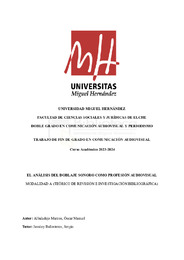Por favor, use este identificador para citar o enlazar este ítem:
https://hdl.handle.net/11000/33332Registro completo de metadatos
| Campo DC | Valor | Lengua/Idioma |
|---|---|---|
| dc.contributor.advisor | Javaloy Ballesteros, Sergio | - |
| dc.contributor.author | Albaladejo Marcos, Óscar Manuel | - |
| dc.contributor.other | Departamentos de la UMH::Ciencias Sociales y Humanas | es_ES |
| dc.date.accessioned | 2024-09-27T14:38:54Z | - |
| dc.date.available | 2024-09-27T14:38:54Z | - |
| dc.date.created | 2024-06 | - |
| dc.identifier.uri | https://hdl.handle.net/11000/33332 | - |
| dc.description.abstract | El doblaje es una profesión invisible que constituye parte fundamental del audiovisual y ha evolucionado desde sus inicios hasta convertirse en un componente esencial de la industria. Las distintas áreas técnicas que se han desarrollado a lo largo de su historia como la traducción y adaptación de guión, dirección y actuación de doblaje, y apartado técnico de sonido e imagen, demuestran que es una profesión que cubre todas las ramas del audiovisual. El análisis de dichas áreas de la profesión, así como de su historia, dan respuesta a dilemas como el grado de relevancia que posee la traducción y adaptación en el atractivo de la obra; el impacto del avance de las nuevas tecnologías en la profesión y cómo puede afectar al futuro de la misma, y el motivo de la tendencia actual del público a preferir consumir obras en su idioma original con subtítulos en vez de doblados. El objetivo de este estudio es demostrar la relevancia del audiovisual como profesión y su calado en el audiovisual a través del análisis de la profesión desde una perspectiva histórica, técnica y analítica mediante el estudio de las distintas áreas de la profesión y referentes de la misma. | es_ES |
| dc.description.abstract | Dubbing is an invisible profession that is a fundamental part of the audiovisual industry and has evolved from its beginnings to become an essential component of the industry. The different technical areas that have developed throughout its history, such as script translation and adaptation, dubbing direction and acting, and sound and image technical aspects, show that it is a profession that covers all branches of the audiovisual industry. The analysis of these areas of the profession, as well as its history, provides answers to dilemmas such as the degree of relevance of translation and adaptation in the attractiveness of the work; the impact of the advance of new technologies on the profession and how it may affect its future; and the reason for the current tendency of audiences to prefer to consume works in their original language with subtitles rather than dubbed versions. The aim of this study is to demonstrate the relevance of audiovisuals as a profession and its impact on the audiovisual industry by analyzing the profession from a historical, technical and analytical perspective through the study of the different areas of the profession and its benchmarks. | es_ES |
| dc.format | application/pdf | es_ES |
| dc.format.extent | 30 | es_ES |
| dc.language.iso | spa | es_ES |
| dc.publisher | Universidad Miguel Hernández de Elche | es_ES |
| dc.rights | info:eu-repo/semantics/openAccess | es_ES |
| dc.rights | Attribution-NonCommercial-NoDerivatives 4.0 Internacional | * |
| dc.rights.uri | http://creativecommons.org/licenses/by-nc-nd/4.0/ | * |
| dc.subject | Análisis | es_ES |
| dc.subject | Historia | es_ES |
| dc.subject | Doblaje | es_ES |
| dc.subject | Profesión | es_ES |
| dc.subject | Audiovisual | es_ES |
| dc.subject | Analysis | es_ES |
| dc.subject | History | es_ES |
| dc.subject | Dubbing | es_ES |
| dc.subject | Profession | es_ES |
| dc.subject | Audiovisual | es_ES |
| dc.subject.other | CDU::7 - Bellas artes::77 - Fotografía. Cinematografía | es_ES |
| dc.title | El análisis del doblaje sonoro como profesión audiovisual | es_ES |
| dc.type | info:eu-repo/semantics/bachelorThesis | es_ES |

Ver/Abrir:
CAU_Albaladejo_Marcos_Óscar.pdf
543,11 kB
Adobe PDF
Compartir:
 La licencia se describe como: Atribución-NonComercial-NoDerivada 4.0 Internacional.
La licencia se describe como: Atribución-NonComercial-NoDerivada 4.0 Internacional.
.png)